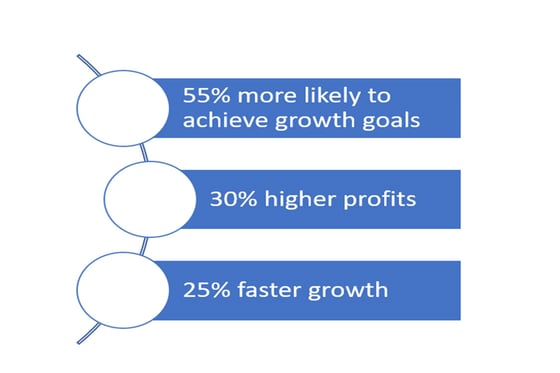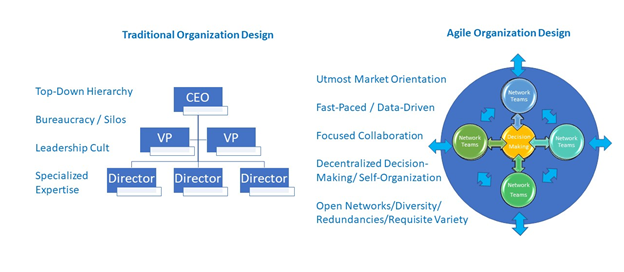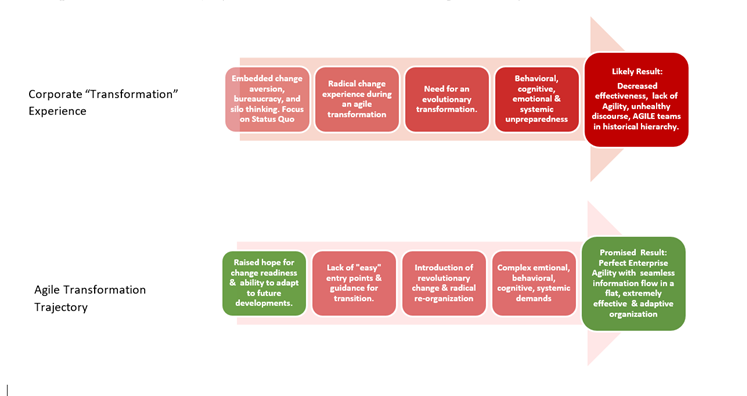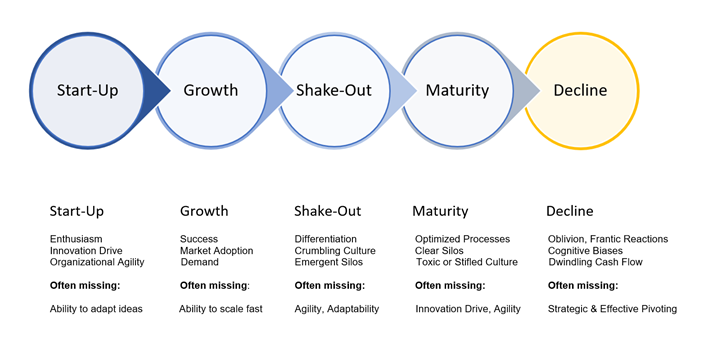Overview: The Agility Advantage • What Makes a Company Adaptable? • Adaptive Organization Design • Underlying Principles • The Agile Transformation Crux • Getting Started in Your Own Small Ways • Basic Reflective Questions •Assessment: Is Your Company Ready to Grow?
The unprecedented speed of technological developments, customer demands, employee expectations, and never before experienced global threats have dramatically changed what is necessary for business success. Companies are now compelled to react and adapt in order to survive and thrive.
Traditionally, size was all that mattered in business. Giants would outperform smaller companies. Therefore, knowing how to scale and optimize performance was one of the most crucial skill sets to have. Today, size alone is not enough. With increasing frequency, companies must be able to scale (up or down) at a breathtaking pace. Consequently, the ability to scale must be coupled with the ability to adapt and flexibly act to maneuver planned or unplanned change. Moreover, companies must consistently rethink what is possible while trying to predict future developments. Today's business environment requires successful companies to constantly push the envelope and proactively innovate for emergent needs rather than the current status quo.
Business Agility encompasses the practices, structures, and skills that enable a company to predict and swiftly adapt to unforeseen circumstances while seizing new opportunities that become available through them. Simply put: Agility allows a company to react fast whenever and wherever needed. Because of that nimbleness, Business Agility has become one of the most sought-after concepts of the 21st century. The approach is also known as Enterprise Agility, Adaptability, Large-Scale Agility, or Agility-at-Scale.
___“Success today requires the agility and drive to constantly rethink, reinvigorate, react, and reinvent.”— Bill Gates
 Graphic 1. Advantages of an adaptive and agile organization
Graphic 1. Advantages of an adaptive and agile organization
Evidently, in our current hyper VUCA (Vulnerability, Uncertainty, Complexity, Ambiguity) business environment, companies that can easily adapt have a competitive advantage. On the one hand, nimbleness and structurally embedded change readiness can save a company from being disrupted and ultimately wiped out of the market. On the other hand, fast, future-oriented, and data-driven decision-making processes present first-class opportunities to drive business excellence, employee engagement as well as brand awareness. The deep structural preparedness for both sides of the spectrum consistently fuels success.
The wide range of operational advantages delivers measurable results. An Accenture study found that truly agile organizations show a 55% percent likelihood of achieving financial growth goals quarter by quarter, whereas traditional organizations only show a 25% likelihood. An MIT study further revealed that agile companies grow 27% faster and generate 30% higher profits. McKinsey reports an increase of a client’s EBITDA by $250 million, a 20% share price increase due to a reduction of a company’s cost basis by 30%, increased customer satisfaction as well as employee engagement, and a 25% increase in organizational effectiveness (McKinsey, January 22, 2018).
____“It is not the strongest of the species that survives, nor the most intelligent. It is the one that is most adaptable to change.” ―Charles Darwin ____
Given the drastically changing business landscape, the question of what makes a company more adaptable has been a focal point for researchers. Already in 1991, Goldman, Preiss, and Dove discovered that traditional systems of mass-production and optimization did not leave enough room for making fast and incremental changes to stay successful against competitors and disruptors. The call for new ways of organizing became louder and sparked rich research streams from varying perspectives.
In short, increased adaptability requires an individualized as well as a holistic approach spanning a minimum of 7 organizational and human aspects:
An Agile Organization differs in its:
True Business Agility can only unfold if these 7 features work hand-in-hand. Additionally, companies must find their unique Agility style. Only businesses that manage to adapt AND stand out in the market, thrive.

Graphic 2. Traditional vs Agile Organization Design
Some of the most distinguishing factors in companies that strive for Business Agility are their organization design, workflows, and structures.
Traditional companies tend to be organized in steep hierarchies with a top-down decision-making process. During times when notions of stability and control defined most business models, hierarchies seemed to ensure fast decision-making and utmost optimization. Decisions in a hierarchical organization are typically made at the top and "trickled down." The goal of decision-making typically is alignment and utmost efficiency.
In comparison, agility-driven companies are organized in flat, lean, network-oriented, and to varying degrees self-organized. This innovative organizational design allows companies to achieve more, adapt faster, and be prepared for the unpreparable -- to either charter new territory or pivot as needed.
The Underlying Principles of an Agile Organization Design Are:
That bandwidth makes Enterprise Agility one of the few approaches that include collaborative leadership, strategy, organization design, culture, and behavior toward competitors, suppliers, and the overall environment.
In today's volatile business landscape, we have sufficient evidence that hierarchies are not the most effective form of organization. On the contrary, they can slow down a company's change and innovation readiness as well as its adaptability.
____"The most important things cannot be measured. The issues that are most important, long term, cannot be measured in advance." —Edwards Deming ____
The upsides of improved profitability, scalability, and innovation capacity speak for themselves. Ironically, however, that is not to say that Agile Approaches have widely been embraced nor that all Agile Transformation attempts succeed.
A 2018 McKinsey Quarterly survey report revealed that only a few of 2500 participating companies achieved organization-wide agility. While 40% started the respective transformation process, only under 10% managed to complete it.
Researchers have drilled down to the heart of said crux. For example, Karvonen, Sharp, Barroca (2018) report that when the Agile Business Consortium of the Open University asked the study participants: “Why is Agile Transformation so hard?” companies identified five main challenges:
The contrast between what was being promised and actual outcomes often couldn't be wider. As we can see in Graphic 3, the client experience remains challenging if transformation efforts do not meet the clients where they are and if Agile principles are sought to be implemented top-down without sufficient collaborative transformation efforts of the existing mindsets.

Graphic 3. Clash: The typical Clients' Experience vs. Promised Traditional Agile Transformation Trajectories
Deterred by the high failure rates of transformation attempts and the required time commitment, companies may hesitate to act resulting in detrimental inertia just when prudent action is most needed.
____“ In a world that's changing really quickly, the only strategy that is guaranteed to fail is not taking risks.” ―Mark Zuckerberg ____
The bottom line is: In our turbulent times, all companies are at risk of being thrown out of business or slowed down. Surviving and thriving require adaptive solutions but also require understanding that there is no single "one-size-fits-all" transformation solution.
Companies differ immensely across industries, business objectives, growth goals, and life cycles. Consequently, even the smallest transformation and scale efforts must be tailored to specific business needs.
For example, more traditional, larger companies tend to have a well-established brand identity, great resources, and proven procedures. However, they are less nimble than start-ups and often have a more rigid mindset that is deeply anchored in historically based silo-thinking. In contrast, start-ups tend to come equipped with the advantage of very versatile size, which often fuels a relentless innovation drive and a “nothing-to-lose” attitude. That said, the majority of start-ups cannot adapt their initial idea as needed or scale fast and savvy enough to establish a long-term standing in the market. Moreover, once a start-up has become established, it faces the same issues as a traditional company.
Agile Organizations must be focused and collaborative to be effective. It is possible to start small by homing in and resolving issues that truly matter to the respective company and its current life-cycle phase. Also, by starting small, it is easier to simultaneously practice new forms of collaboration, organizing, and leading.
 Graphic 4: Agility Risks & Opportunities per Growth Phase and Life-Cycle Stage.
Graphic 4: Agility Risks & Opportunities per Growth Phase and Life-Cycle Stage.
As mentioned, a company can use Agility Approaches to tackle isolated issues in a focused and collaborative way. Taking this approach is a fantastic way to start walking the talk. A great starting point is to apply Agility Practices to driving a company's organizational identity (Jacobi, 2018) and brand awareness.
As is well-known and often painfully felt, getting your brand to stand out in a volatile market is not an easy feat. Companies have a tendency to become look- and feel-alike over time. This phenomenon is called Isomorphism. To avoid the pitfall of sounding and feeling like competitors, forward-thinking companies can deploy common Agility Practices to become organizationally and mentally more adaptive and by doing so simultaneously increase engagement, identity, and brand recognition.
The fear of introducing drastic changes to a company in times of fast-paced growth or in times of struggle is understandable and justified.
While transformational adaptability is a holistic affair, there are many things companies can do to ease into the process. To get started, one can examine available company data to understand where your organization currently stands. From there, it is easier to decide what needs to be done next. To ease into the process, it is recommended to initially only focus on one area of improvement. To successfully accomplish change in this one area, however, make sure to apply the necessary focus and collaboration identified above as two basic Agility Principles.
Here is an easy rule of thumb: If you are not working toward creating solutions together, you are neither working on increased Agility nor Engagement and Brand Identity. If you are not focused, on a relevant topic, you are neither following Agile Principles nor do you increase your likelihood of success.
The following offers a basic reflective assessment of the structures and behaviors in your company or team. The analysis - at best discussed with colleagues that see the same need - can help raise awareness of the one problem that might be good for you to home in on.
____ "What gets measured, gets changed."- Peter Drucker _____

On a scale from 1-7
First, select the set of questions that matches your life-cycle stage and size best. Discuss the score you'd give yourself among like-minded people on your team or in your organization. Understand where you are, take the guiding questions as further food for thought, and the opportunity to collaboratively focus on the topic that matters to you -- that is, the topic that helps you best to ease into your Adaptability practices best. Enjoy the process and remember to view this is as an opportunity - not a chore.
For Start-Ups
Your Guiding Question: How can you improve your Cognitive Agility, i.e., your Agile Mindset? How can best target offerings to current and future market needs?
For Start-Ups in Exponential Growth Phases
Your Guiding Questions: How can you structure for continued success? How can you stay lean, nimble, and energetic at the same time? How can you ensure that your people remain engaged and their expertise is utilized to the fullest?
For Small To Mid-Sized Companies (SMEs)
Your Guiding Questions: How can you pivot from mediocrity to excellence? How can you create more room for self-organization, ownership, and intrapreneurship? How can you revive your culture, increase engagement, and utilize your people's expertise?
Your Guiding Questions: How Can You Drive Renewal from Within? What is the most prominent mindset change that needs to happen? Are there other business and operational models that would help you become leaner and more adaptive?
Companies in Decline
Your Guiding Questions: How Can You Collectively Focus on Pivoting in Healthy Ways? What is the one thing that really needs to change? How can you find balance as you are going through challenging times?
Has this self-assessment given you and your colleagues food for thought? If so, note that you can use these simple questions to start practicing an Agile Mindset. Here is how:
Observe yourself as you are going through these questions. Are you convinced you know what needs to happen? Are you overly invested in one outcome? If you answer these questions "Yes," then it is time to work on an Agile Mindset.
To do so, you can ask yourself as an individual or team: What if your perspective was not right? What if things were not as rosy or horrific as you might think? What if your colleagues' opinions were more valid than yours? What do you require to change your own opinion? What are colleagues' points of view? How do they change yours? --
What you may experience as you go through this assessment and follow-up discussions is a taste of the actual work that practicing an Agile Mindset and true Agile Transformation takes. Like with many other things, we may not achieve perfection. Nonetheless, we must make room for practicing and cultivating Adaptability Practices (whether emotional, cognitive, or systemic) - if we are serious about wanting to achieve full-functioning Business Agility.
___
Is your company ready to grow? Take the test.
Signs that Your Company is not Agile.
Agile Decision-Making: Clarity versus Confidence
Learn more: Enterprise Agility Design & Certification Course.
Need consulting advice? Schedule a free call.